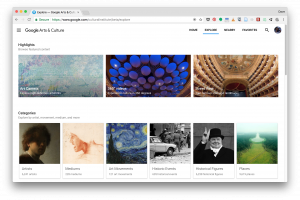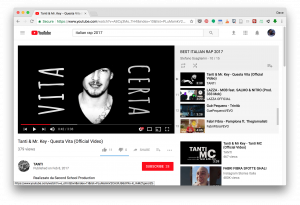This semester’s technology events program kicked off last Tuesday, Jan. 23rd, with 10-minute Tech Talks–short, informal presentations or conversations by language instructors about a technology-related innovation, application, or question, with time for feedback and discussion with peers. In particular, this opening session asked presenters to share tools and technologies they’re curious about or have just begun exploring, or to reflect on ways in which they apply familiar technologies to serve particular instructional and learning needs in their classes.
 Sarab Al Ani began with a challenge that she faces in her Arabic classes: how to help students find culturally authentic materials without a huge investment of time and resources on the part of both the student and the teacher? The resource she shared with us was Google Arts & Culture, a project of the Google Cultural Institute to promote the discovery and study of cultural works of art. In addition to searching for works of art by artist, genre, medium, place, historic events and figures, Sarab mentioned that students can tag particular works as personal favorites (try it here), and also create, curate and share folders with items on their own, or in teams.
Sarab Al Ani began with a challenge that she faces in her Arabic classes: how to help students find culturally authentic materials without a huge investment of time and resources on the part of both the student and the teacher? The resource she shared with us was Google Arts & Culture, a project of the Google Cultural Institute to promote the discovery and study of cultural works of art. In addition to searching for works of art by artist, genre, medium, place, historic events and figures, Sarab mentioned that students can tag particular works as personal favorites (try it here), and also create, curate and share folders with items on their own, or in teams.
 The second talk was given by Anna Iacovella, who shared activities she conducts with YouTube music videos in her Italian classes, spanning more form-focused cloze-style activities (having students identify uses of the future tense in a song, for instance), to discussions and activities about the rich cultural representations in these videos. As in Sarab’s tech talk, the great opportunities (and a few risks) of bringing authentic materials to the classroom–and inviting the students to find and bring their own for sharing–were at the forefront of this discussion.
The second talk was given by Anna Iacovella, who shared activities she conducts with YouTube music videos in her Italian classes, spanning more form-focused cloze-style activities (having students identify uses of the future tense in a song, for instance), to discussions and activities about the rich cultural representations in these videos. As in Sarab’s tech talk, the great opportunities (and a few risks) of bringing authentic materials to the classroom–and inviting the students to find and bring their own for sharing–were at the forefront of this discussion.
Krystyna Illakowicz gave the third tech talk, reflecting on how her experience teaching a Polish class via room-to-room videoconferencing in 2015 (part of the Yale-Columbia-Cornell Shared Course Initiative) has continued to inform the way she uses technology in her traditional face-to-face classrooms. She wrote,
One practice that relates to my distance learning class I taught a few years ago is using the smart board techniques in the classroom without a smart board. I noticed that during my distance learning classes (Advanced Polish L5) the students liked using the smartboard. The class entailed quite a lot of writing and we workshopped students’ texts projecting them on the smartboard. We discussed vocabulary, grammar, and stylistic issues making the corrections right on the smartboard. The students told me, and I could see that myself, how they enjoyed working that way, because the collaborative effort and engagement with technology must have made the “correction” process more enjoyable and that type of engagement with their texts helped them to remember the grammar forms or new words better.
Later, when teaching my regular Advanced Polish without a smartboard, I started projecting student texts via email and we worked on student texts in a similar way as in the divided classroom. Perhaps the smartboard fun is missing, but the effects are similar.
That kind of class work could, of course, be done without a prior smart board experience, but it was the smartboard technology that lead me to such a solution and, as David noticed, it would not become so obvious without a smart board. The smartboard became a kind of a bridge or platform for thinking about such ideas and in some way enabled us to “domesticate” some technological solutions and made them a part of our daily practice.
Have you tried using these or other tools in your classrooms, or want to talk about how you might? Leave a comment below and let’s trade ideas.
Thank you again for the inspiration, Sarab, Anna, and Krystyna!